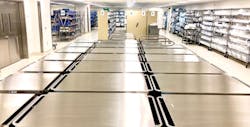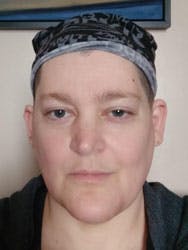As surgical procedure volumes grow, as does awareness around the importance of thoroughly clean and sterilized instruments, many health systems and hospitals are revamping their existing central sterile/sterile processing departments (CS/SPD), and in some cases building completely new spaces featuring improved workflows and state of the art equipment.
This month we highlight four healthcare organizations that have performed CS/SPD “makeovers,” each with their own priorities, approach, design and equipment. We also present expert tips and best practices from CS/SPD professionals and equipment vendors around design planning, space layout, storage, instrument tracking and asset management.
A rebuild of staff and structure
When Shawn Huelsman, CRMST, GTS, VHA-CM, AAS-ST, BSHM, Assistant Chief, Sterile Processing Service (SPS) at Department of Veterans Affairs, joined Louis Stokes Cleveland VA Medical Center six years ago, the SPS was experiencing complete turnover in its leadership. The department was also in need of updated sterile processing equipment. As a result, Huelsman and his team were tasked with not only restructuring the equipment side of the department, but the personnel side too.
“We worked to get new people on board who cared about the mission as much as we did — individuals who would do the best possible job that they could do,” said Huelsman.
Once the new SPS leadership team was in place, they tackled the challenge of updating processes and equipment. They had to stay within the original footprint of the department, but fortunately newer technologies, such as washers, were smaller than what they had previously been so it afforded them additional space. To maximize the space they also implemented new storage systems for instrument trays.
“I am very fortunate to have administration on my side to understand the depths of what we do in the SPS,” said Huelsman. “We have their support to obtain any equipment we need to perform the best quality work for our veterans.”
A prime focus of the team was improving the instrument inspection and visualization process. They implemented a stero microscope that Huelsman describes as a “game changer,” enabling technicians to visualize pitting and rust that could not be viewed through regular magnifiers. They also implemented two fluoroscopes — one 1.6 mm in diameter and the other .5 mm – for enhanced visualizing during the cleaning process.
Huelsman’s advice to other sterile processing professionals who are rebuilding or renovating their departments:
“Don’t be afraid to ask for what you need and present the facts to your healthcare organization’s leaders. In our case we are running a sterilizer 24 hours a day and processing 6.5 million instruments per year. We explained to leadership that we needed new equipment so that we could continue providing the OR with safe and effective instruments — when they need them — thereby minimizing the risk for costly OR downtime or surgical site infections.”
A Lean layout
A Florida health system with two hospitals (700 beds) was planning to renovate its operating rooms (OR) and recognized that it must, at the same time, revamp its CS/SPD space to support growing procedural volumes. They leveraged the resources of the health system’s Lean process department to help them design a space with improved workflow and features to support current needs and future growth.
Through a Lean 3P (Production, Preparation, Process) event, the CS/SPD team, in conjunction with the Lean process department, built a mock CS/SPD department out on cardboard within a large auditorium area in one of the hospitals. It included cardboard mock-ups of everything that they would need in the new department — sinks, washers, workstations, etc. They even brought in real items from their current department to help with the design planning, such as case carts.
Each member of the CS/SPD team had the opportunity to walk through this life-sized 3-D cardboard mock-up of the department and provide their feedback on what worked and what didn’t in terms of design. Through this exercise they discovered better ways to position equipment for greater efficiency and productivity.
For example, the existing department had six workstations that were positioned in a square around a central printer. When a technician needed to retrieve something from the printer, he or she had to walk around all of the other workstations in order to get it, and then walk all the way back. Using the mock department, they discovered that placing two workstations together with a printer in between eliminated these unnecessary and time-consuming steps.
The health system’s manager of sterile processing offers the following advice to others who are rebuilding or remodeling their departments:
“Always check on what is being built — be involved as much as you can. Don’t assume that somebody else knows what you are thinking. You can’t go backwards so you always want to stay ahead of things before they happen.”
A radical transformation
In December 2008, Lucile Packard Children’s Hospital built out seven new ORs and converted what had originally been planned as another OR suite to serve as the CS/SPD. Prior to the organization opening its new hospital in December 2017, leadership recognized that it needed a much larger and better-equipped CS/SPD to meet current needs and support future growth as well.
“In the old department you could literally look through decontamination into prep and pack through the washer doors and have a conversation with someone on the other side,” said Shawn Flynn, CRCST, CIS, CHL, Manager, Sterile Processing/OR Services, Stanford Children’s Health, Lucile Packard Children’s Hospital. “The CS/SPD team went from this very small 1,513 sq ft to a 12,079 sq ft footprint and from basic but necessary equipment to a huge new space with cutting-edge technologies. This was an 832 percent increase in space. When I had the opportunity to lead the department I got not only a great team but also a fantastic department that was designed and built as it should be.”
The new CS/SPD contains state of the art equipment designed to enhance workflows, safety and staff comfort, enabling technicians to effectively and efficiently deliver high quality instruments to the ORs. This includes height adjustable decontamination sinks and workstations, fully automated washers, boroscopes for flexible scope/lumen cleaning verification, a scope control unit for diagnostic testing for rigid/semi rigid scopes, and a surgical instrument NuTrace laser marking system to track instruments used in the operating room and each of the hospital’s 20-plus clinics.
Flynn offers the following advice on renovating or rebuilding the CS/SPD:
“When deciding on space design and equipment be sure to engage a cross-functional team that includes end-users in the decision making process. While the architect is an expert in his or her field, he or she won’t necessarily know the intimate aspects of the department that the end-users will know. Also, be sure to plan for growth because you don’t want to discover at the time of the move-in that you have already reached capacity. Lastly, make sure leadership is there to manage change. A new department is exciting but many of the processes, workflow and equipment will be new to everyone. This can be a very stressful time and consistent leadership and training will go a long way in having a successful opening.”
officially opened its new sterile processing department.
A focus on scopes
While the Hennepin Healthcare CS/SPD team was adhering to industry best practices and guidelines for scope reprocessing, the department recognized the need for greater efficiency. They had two full-time employees who spent all of their time processing scopes, including 20 minutes blowing air into them to ensure they were completely dry prior to storage.
So when they were designing the new Hennepin Healthcare Clinic & Specialty Center, the CS/SPD team decided to implement advanced equipment that would not only exceed industry standards for efficacy and safety, but also boost productivity. They implemented Cantel Medical’s ADVANTAGE PLUS Pass-Thru Automated Endoscope Reprocessor (AER) and the company’s Pass-through ENDODRY Cabinet, which enhance infection prevention by establishing a physical separation between “dirty and clean” areas, and automate processes for integrated high-level disinfection, drying, storage and endoscope security tracking.
According to Darren Dahlin, Senior Product Manager, Medivators, a Cantel Medical company, there are several key points where an endoscope must be tracked or monitored throughout the entire process from patient to patient. Once the procedure is over the facility must track pre-cleaning, performance of the leak test, the manual clean process, the AER high level disinfection cycle, and storage and dry time — then the scope must be checked in again when it gets back to the next procedure room.
“The ADVANTAGE PLUS AER and ENDODRY Cabinet each perform their own monitoring and tracking of each step. Furthermore, they communicate with each other so if a scope has not been processed through the AER the drying cabinet will not accept it,” explains Dahlin.
The Hennepin Healthcare Clinic & Specialty Center team also employs Cantel’s point of use tracking system, ENDORA, where technicians use a kiosk at each station to scan their own barcode and then the scope’s barcode to track reprocessing steps. Next, the clinician scans the scope at the point-of-use so that he or she can verify that the scope has undergone all of the necessary processing steps and is safe to use on the patient.
Top tips from the experts
While each CS/SPD is different, there are common best practices that sterile processing professionals can implement when approaching a department renovation or rebuild. We reached out to some industry experts to obtain their insights on the process.
Plan for success
Steve Sutton, Director, Planning and Design Group, Belimed, says the first priority is to enlist the help of a competent and capable project manager. He states: “You do not have time to manage the budget, schedule, vendors, engineers and sub-contractors needed to renovate a modern central sterile department. If your hospital does not have a dedicated project management team for this kind of work, I would recommend they outsource that role to another firm (typically called the Owner’s Rep).”
“Secondly, you need a plan,” Sutton added. “The project team must have a fully developed plan for the project BEFORE starting demo or construction. Will it be phased? How will the operating room continue to be supported during the project? How will this project affect your standard policies and procedures? This should all be addressed in a detailed project plan complete with drawings and a clear narrative.”
“This is a major endeavor. It’s never as easy as it seems, but it can be so rewarding not only for your career, but also for the patients to whom you provide instrumentation,” said Michele DeMeo, CSPDT, CRCST, Independent CS/SPD Consultant at MDD Virtual Consulting. “The process even for the most experienced director will be another wonderful learning experience. Make sure you go in prepared and keep investigating, especially, if you already know what to do. The biggest errors occur with over-confidence.”
Here are five tips that DeMeo offers to help with the decision making process:
- Develop an overview of the current department, its statistical information, and projected workload for 1, 3, 5 and 10 years in all surgical specialties and as a whole
- Create a realistic timeframe and timeline with tasks that are aligned with responsible parties for each necessity
- Investigate appropriate vendors for all needed items and construction with the help of materials management, facilities management, infection control, etc.
- Tour other facilities of similar workload production that you ANTICIPATE – not what you are currently doing
- Ensure that if the unit is going to still be housed within the same facility, that the utilities and general mechanics are – or will be – robust enough to handle greater demands from the new CS/SPD (e.g. proper air flow, water filtration, general plumbing, electrical outlets, etc.)
Tom Wescott, Surgical Workflows Regional Sales Director, North Region — USA, Getinge, points out how CS/SPD teams must consider how they will prevent disruptions to their current operations while they are renovating their current space or building a new one. He states:
“Imagine an auto mechanic performing a major engine repair with the motor still running. When renovating the CSSD, clinicians and administrators face a similar dilemma. The number-one imperative before any architectural renderings or equipment specs have been completed is to ensure a plan is in place to safeguard uninterrupted processing workflows from a temporary location, on-site mobile unit or through outsourcing.
“Concurrently, a comprehensive analysis should be conducted regarding trends in the volume and type of procedures being performed in the hospital’s ORs,” added Wescott. “Continual advancements in image-guided and robotic surgeries across multiple disciplines necessitate enhanced scrutiny of the productivity capabilities of low-temperature sterilization and ultrasonic cleaning equipment. Plus, steam sterilizers and washer-disinfectors need to accommodate anticipated workload volumes over the next seven years.”
Involve the end-users
“Be sure to involve the end-users working inside the department every day,” said Brent Snyder, Implementation Manager, Censis. “Renovating a department takes a lot of planning and coordination between technical specialties, and often at a high level. The end-users who will be functioning in the highly regulated space have firsthand experience of how to accomplish sterile processing tasks, which is valuable insight to the team working on the department’s new design.”
Leverage vendor relationships
“A significant number of projects involve renovation or rebuild, and embedding your technology providers early on will significantly facilitate integration, interoperability and eventually performances down the line,” said Michel Gillmann, Marketing Director, Xerafy. “We regularly have professionals reaching out to us to better understand the latest technologies available in the market, which helps tremendously when it comes to us understanding the intricacies of reprocessing.
“We see that the most common drivers for resorting to technology are about driving patient safety, reducing manual work and turnaround times, meeting regulatory requirements, as well as quality and cost objectives,” Gillmann added. “The topic of data is increasingly popular, be it for compliance or more recently to feed artificial intelligence. Today, data gives the ability to understand usage and reduce inventory through analytics, as well as making process improvements directly visible.”
Understand your assets
“One critical area hospitals should include in the pre-expansion process is the structure and volume of their surgical instrument sets,” said Sandra Countley, Marketing Manager, Surgical Asset Management, Aesculap. “We have found that on average, hospitals have a 16 percent surplus of instruments in their surgical sets. If structure and size of existing sets are not optimal, purchasing additional sets in the same structure and size multiplies any current inefficiencies, such as issues in supporting additional caseloads. In addition, on-going reprocessing of these overloaded sets can lead to unnecessary costs. Therefore, we recommend that facilities standardize and optimize their current instrument sets prior to expansion.”
Aesculap’s Surgical Asset Management (SAM) Program is designed to help hospitals meet their long-term efficiency goals. An Aesculap SAM consultant works with the facility to identify actionable savings opportunities for upfront purchases and the reprocessing cycle. Hospitals engaging in optimization projects have been able to reduce surgical instrument inventory by an average of 18 percent, resulting in a minimum of $83,000 of saved reprocessing costs per year.*
*Data on file.
Shore up your storage
“There are three main areas that often get overlooked when designing a CS/SPD: Case cart storage, instrument storage and vendor tray holding areas,” said Amanda H. Coss, CSPDS, CSPM, CRCST, CIS, CHL, National Education Coordinator, Mobile Instrument Service & Repair. “For case carts, you need three different areas to accommodate a case cart system: Decontamination holding area to increase efficiency and promote employee safety; a clean area to store carts that have not been prepared for cases; and a sterile environment for storage of assembled cases.
“Designing for proper instrument storage prevents over-crowded, unsafe working practices and avoids stacking,” Coss adds. “Make sure you plan for room to store all facility and loaner trays in a single layer. And finally, for vendor trays that have been cleaned and are not scheduled for use in future cases, plan for a dedicated room for the storage of these trays.”
David Phillips, Marketing Manager, Hänel Storage Systems, cites Cardinal Health’s 2018 survey data, where 73 percent of frontline clinicians recalled a time when a physician didn’t have the product needed for a procedure during the procedure. “This could mean that an item wasn’t found in time for the procedure, or it needed to be re-sterilized for some reason,” he explains.
“Greater inventory accuracy and protection could solve both of these issues,” Phillips adds. “In addition, 65 percent of administrators realize that they don’t have enough room in their supply storage rooms. This indicates that a department renovation or rebuild should allocate more storage space for their new department, or if that’s not possible, then maximize what little amount of storage space they will have. In all of these instances, a vertical carousel fits the bill.”

Kara Nadeau | Senior Contributing Editor
Kara Nadeau is Sterile Processing Editor for Healthcare Purchasing News.



















